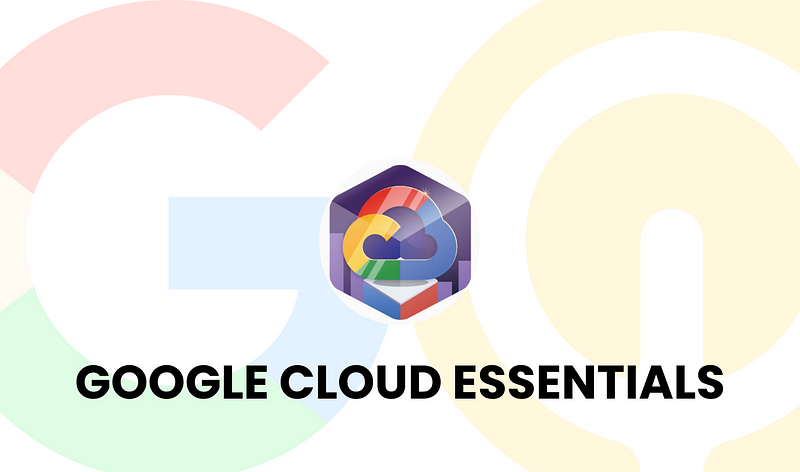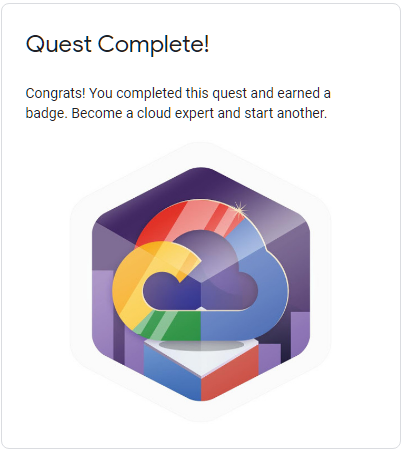Google Cloud Essentials Quest: An Overview of Key Concepts and Skills
 Rahul Bhatt
Rahul Bhatt
An Overview
If you looking to learn about Google Cloud in depth or in general with or without any prior knowledge in cloud computing, then you should definitely check this quest out, Link.
Google Could Essentials is an introductory level Quest which is useful to learn about the basic fundamentals of Google Cloud. From writing Cloud Shell commands and deploying my first virtual machine, to running applications on Kubernetes Engine or with load balancing, Google Cloud Essentials is a prime introduction to the platform’s basic features.
Let’s see what was the Quest Outline:
- A Tour of Qwiklabs and Google Cloud
- Creating a Virtual Machine
- Getting Started with Cloud Shell & gcloud
- Kubernetes Engine: Qwik Start
- Set Up Network and HTTP Load Balancers
A Tour of Qwiklabs and Google Cloud was the first hands-on lab which basically gives an overview about Google Cloud. There were few questions to answers that will check your understanding about the topic and the rest was about accessing Google cloud console, projects in cloud console, roles and permissions, Cloud Shell and so on.
Creating a Virtual Machine was the second lab to create virtual machine and also connect NGINX web server to it. Compute Engine lets one create virtual machine whose resources live in certain regions or zones. NGINX web server is used as load balancer. The job of a load balancer is to distribute workloads across multiple computing resources. Creating these two along with a question would mark the end of the second lab.
Getting Started with Cloud Shell & gcloud was the third lab session. Google Cloud Shell provides gcloud command-line access to computing resources which are hosted on the Google Cloud. Cloud Shell is a Debian-based virtual machine. The Cloud SDK gcloud and other utilities comes pre-installed in Cloud Shell. The session starts by initializing Cloud SDK and setting environment variables and then finally creating a virtual machine of type n1-standard-2.
Kubernetes Engine: Qwik Start was the fourth lab. If you don’t know what’s Google Kubernetes Engine (GKE), it basically allows you to specify how much CPU and memory (RAM) each container needs, which is used to to better organize workloads within a cluster. GKE provides a managed environment for managing, and scaling containerized applications using Google infrastructure. The Kubernetes Engine environment consists of multiple machines grouped together to form a container cluster. The session begins by setting a default compute zone to us-central1-a and the creating a Kubernetes Engine Cluster. A cluster consists of at least one cluster master machine and multiple worker machine called nodes. Then you must authenticate credentials for the cluster you just created, after which you can deploy an application to the cluster.
Set Up Network and HTTP Load Balancers was the last lab. This lab teaches you about Cloud Load Balancing and the difference between a network load balancer and a HTTP load balancer. A load balancer distributes user traffic across multiple instances of a application. By spreading the load, it reduces the risks of slow and nonfunctional. Based on types of traffic you can use load balancers for HTTP and HTTPS traffic, TCP traffic and UDP traffic. In this lab you will be only using L3 : Network Load Balancer , L7 : HTTP(S) Load Balancer. The session begins with settings default region and zone for all the resource which you learned in the previous labs. Then you’ll be creating multiple web server instances by creating a simple cluster of Nginx web server. Then you’ll be creating a Network Load Balancer for balancing the load of the system based on incoming IP protocol data, such as address, port, and protocol type. Then you’ll create a HTTP(s) Load Balancer but before you will run a basic health check command to verify that the instance is responding to HTTP and HTTPS traffic. Thus, this marks the end of Google Cloud Essentials Quest.
Thank you for reading. You can check the authenticity of the quest completed on my LinkedIn profile : LinkedIn-RahulBhatt

Fig.1. Completed the quest of Google Cloud Essentials
Subscribe to my newsletter
Read articles from Rahul Bhatt directly inside your inbox. Subscribe to the newsletter, and don't miss out.
Written by
